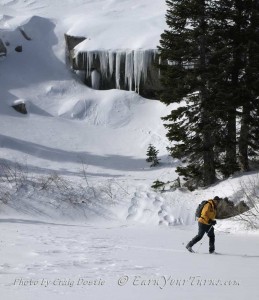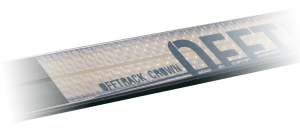For years now my number one go to ski has been the Karhu Guide. But the bases are getting nicked and scratched so it ices up too easy. On tap to replace it is Fischer’s fattest S-Bound ski, the 112.

Fischer's S-Bound 112. Plenty of width for flotation, plenty of pattern for grip,
and a nice sidecut for easy turns.
Two years ago I replaced the pins with a Switchback and went with T2s just ‘cuz they fit better than Excursions. Mostly I used ’em to take the dog for a walk, so they get used like a classic cross-country ski more than shredders. If all that sounds heavy for a striding ski you’re thinking inside the anorexic nordic box.
My friend Mick always needles me about my heavy striding gear, but he also noticed that for short jaunts I had no problem keeping up with him. So the difference in weight doesn’t always matter, but I’m the first to admit, and he noticed this too, that on a long day the weight does take its toll. For short tours though, you just get to expend a little more energy, and it’s barely noticeable.
Now it’s not rocket science to know that fatter skis turn better than skinny nordic rigs. Then consider what you want when your backyard has some pitch and you realize you may want some extra width for stability and turns, and metal edges for firm snow and speed. So yes, they are heavier, but worth it.
For those who don’t know how to turn, think of them as fat skis that are easy to balance on, or snowshoes that aren’t slow shoes. In fact, for that, the fatter the better.
Which is another thing few realize. With a fatter ski you might think they create more drag, but actually, and especially when you’re breaking trail they make it easier because they aren’t constantly “submarining” in the snow. Plus they have better grip thanks to more waxless surface area. Breaking trail is why I recommend a Switchback over pins for the binding, so you have a free pivot to let the tips rise to the top. Or SNS-XA or NNN and some beefy boots (see Barnett’s treatise on TeleLite).
As much as I love the Guide for these capabilities, the Guide is about to get replaced. Fischer’s S-Bound 112 is a good contender. It uses a progressive pattern whose scales are shallow at the beginning and end, but deeper in the kick zone. So far it grips really well where I would expect it to, in textured snow – either fresh or refrozen – and in warm, mushy snow. As with other waxless patterns, skins do a much better job on icy surfaces, but if you slow down you can get enough purchase to at least hold position with a small incline. In warm snow they climb well up to 12°, 15° with technique, and are good to 10° in cold textured snow. Like the rest of the S-Bound series, the 112’s have a fair amount of camber. This definitely helps improve the glide, as does the negative pattern, but camber is always a potential problem with turns. If you step forward into a tele turn, prepare to kiss the ground. If you can step back to initiate a turn the tendency for the tip to ricochet as you weight it is reduced enough that they turn pretty darn smooth – it was a pleasant surprise when the S-bound 112s turned as told, right from the get go. Perhaps there is something to Fischer’s concept of Nordic rocker, whereby the shovel and tail lift up as you compress the camber with your weight. As I just said, it was a surprise to see these skis respond so well in spite of the camber. Kudos to Fischer for keeping the camber, but not letting it ruin the run back down.That’s the reason a ski like the S-Bound 112 is so attractive. It works in so many situations. Taking Pepper for a walk. Getting a run in with lunch away from the desk. Or even taking it up a 1000′ hill. Shoot, with skins added you can pretty much go wherever you want. I’ve skied far steeper with far less before and the only negative I can see with the S-Bounds is they wouldn’t be good on steeps because you can’t afford mistakes there and the camber would surely cause one. But for everything from the neighborhood park, to snow-clad foothills these sticks rock. S-Bound – ski bound, where you set the boundaries.
Fischer
S-Bound 112
MSRP: $375
Dimensions: 112-78-95 mm
Lengths available: 159, 169, 179, 189 cm
Weight: 2690 g (5 lbs. 15 oz.) / 179cm pair
Related Posts
Review: Fischer BCX875
© 2012




18 comments
1 ping
Skip to comment form
For starters…..to wide! Remember long skis, the longer the more surface hence speed, which, translates into, easy turns. (speed=turnability) Combined with sidecut, its turn on a dime….We the Kingdom Tele Boys would rather ski a bit longer ski (190’s +) than a short stubby ski. But we do ski a bit differently than the norm as slicability and skiing IN powder, we feel ,is better than ON powder. Good news about S Bound is the bottoms break free on the down, and the camber gives the ski energy and quick lift which can translate into easier turning. Camber is good! Most of us don’t care for the Guide, (to wide) but love the Sbound Rebound which has been discontinued. 88 tip being about as wide as we will go for bc powder. Why? Balance begins to change from a tight stance to a wide stance and fore aft stability to starboard and port, which translates into a downhill balance. We are telemarkers and are not interested in the downhill stance. Teleman
Good info on the Rebound. I’m half with you on width. Don’t like the modern super-fat and obese skis, but prefer skis wider at the waist than you like at the tip. 🙂 Variety is the spice of life, eh?
Everybody has to ski on what they want to ski, or, can afford. W e just like the freedom of lite, flexable, straight tracking, and easily turnable. For downhill areas about anything that gets us down without much work works fine. Teleman
Curious about an update on these. Any comparisons or contrasts you can make with them to other patterned base bc skis like the rossignol bc’s or madhus ?
I’ve heard these climb better than just about anything but haven’t been able to try a pair. Would you consider the voile’s a better alternative especially for a tech binding or they in a different category for you entirely?
Local shop only has the rossignol bc110 in stock and I hate the base pattern.
Lots of questions- thanks for the response in advance.
Assuming the Madshus Annum is the same construction as Karhu’s Guide, I’d give the nod to the S-Bounds for better grip and glide. Can’t comment on Rossi’s BC series as I haven’t skied ’em yet. However, while there are differences in grip between them all, the difference between the Annum and S-Bound is sort of like the difference in glide between mohair and nylon skins. It is noticeable, but not dramatic.
The exception would be the new generation of phat waxless skis. They do have better grip, and noticeably less glide. Physics might predict that.
Great review. I just picked up a pair of S-Bound 112s and will be installing a set of Burnt Mountain Designs LiteSpikes on them. The skis have a “mounting area” printed on them, the middle position of which appears to be balance point. Any suggestions on binding placement? Using a fairly burly plastic boot so am leaning towards something like -1 from BP, thinking this might help keeping the tips up.
Check the relative position of balance point and chord center. It’s been awhile, but I think I went with +1cm from chord center. IME forward of chord center is pretty close to the alpine boot center position, which is better for turns, and good enough for kick ‘n’ glide.
Thanks for the tip. I ended up splitting the difference between CC and BP, seems to work! I am so far very impressed with these skis.
I’ve found that well ahead of “BP” or “CC” works best for me on decent flexing skis such as Fischer Boundless, Rossi BC125’s and Voile’ Vector BC’s…my kind of responsiveness for my style of skiing I guess, better turn iniation and balanced in my experiance (many years but no expert!). Basically I want ball of foot on chord ctr. between perceived contact pionts, front and rear (trickey on rockered skis), so I add 3-1/8 to 4-1/8″ to the above chord ctr. depending on even flex characteristics (more foward for even flex, back some if stff tail). My newer BC125,s and Vector BC’s very nicely responsive! (BC125’s/165cm pin line @ 34-3/8″ from tail; Vector BC/160 @ 34″).
Why did you say this Dostie?: “the only negative I can see with the S-Bounds is they wouldn’t be good on steeps because you can’t afford mistakes there and the camber would surely cause one. “
Camber can get in the way of turning. With really stiff, cambered skis you first need to flatten out the ski before it will turn. Otherwise the camber wants to anti-turn. So on steeps this can be a detriment. Thankfully the camber on the S-bound is not that strong, but it is more pronounced than other waxless metal-edged skis. So by comparison, it is the one to be more careful with on steep slopes. Not impossible, not difficult, but a cautionary note.
Thanks. So crank up on the rise and fall in the lead change? Funny, I learned to tele on double-cambered pattern-base skis. As tourers we thought single-camber when it came in was the road to hell.
On-piste (Downunder usually = firm then heavy as the season progresses) the 112s are similar to my World Pistes only a bit twitchy. Will play with more aggressive changes but the pattern base doesn’t help either at a guess.
Having skied the Guides/Annums and the 112s my experience is that the latter have more snap in the turns, more grip but less glide. That just means a bit more power is needed in ‘kick and glide’.
The Fischer markings are for balance point but you’ll note there’s a series of them. I went 1cm forward of the centre mark and am happy with that.
Have you tried the 2013 version with “nordic rocker”?
That is the version that was tested. IMO “nordic rocker” is simply marketing spin on what happens at the ski tip when the camber is flattened out.
Thanks! One more question.. I think the sound from waxless skis is really annoying. Have you noticed any differences there from Fischer to others?
IME the Fishers are distinctly louder than the Guides/Annums on an icy pack.
I love my S-Bound 112’s. Unfortunately the Voile Switchback and X2 both cause a severe fold right across the top of my foot, so I had to go with o1’s and Synergy’s. A little overkill, but I can play a little more in the steeps. I do find that I am using skins a lot in the more mixed terrain around the lake.
[…] Posts Vector BC review Fischer S-Bound 112 review Share this:PrintEmailShareStumbleUponDiggRedditpinterest Posted in Mid-Fat Skis, Voile, […]